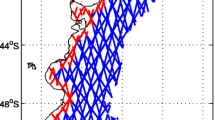Abstract
The accuracy of typhoon forecasts plays an important role in the prediction of storm surges. The uncertainty of a typhoon’s intensity and track means it is necessary to use an ensemble model to predict typhoon storm surges. A hydrodynamic model, which is operational at the National Marine Environmental Forecasting Center, is applied to conduct surge simulations for South China coastal areas using the best track data with parametric wind and pressure models. The results agree well with tidal gauge observations. To improve the calculation efficiency, the hydrodynamic model is modified using CUDA Fortran. The calculation results are almost the same as those from the original model, but the calculation time is reduced by more than 99%. A total of 150 typhoon cases are generated by combining 50 typhoon tracks from the European Centre for Medium-Range Weather Forecasts with three possible typhoon intensity forecasts. The surge ensembles are computed by the improved hydrodynamic model. Based on the simulated storm surges for the different typhoon cases, ensemble and probability forecast products can be provided. The mean ensemble results and probability forecast products are shown to agree well with the observed storm surge caused by Typhoon Mangkhut. The improved model is highly suitable for ensemble numerical forecasts, providing better forecast products for decision-making, and can be easily implemented to run on regular workstations.
Similar content being viewed by others
References
Amouzgar R, Liang Qiuhua, Clarke P J. 2016. Computationally efficient tsunami modeling on Graphics Processing Units (GPUs). International Journal of Offshore and Polar Engineering, 26(2): 154–160, doi: https://doi.org/10.17736/ijope.2016.ak10
Brodtkorb A R, Trond R H, Martin L S. 2013. Graphics processing unit (GPU) programming strategies and trends in GPU computing. Journal of Parallel and Distributed Computing, 73(1): 4–13, doi: https://doi.org/10.1016/j.jpdc.2012.04.003
Bard C M, Dorelli J C. 2014. A simple GPU-accelerated two-dimensional MUSCL-Hancock solver for ideal magnetohydrodynamics. Journal of Computational Physics, 1: 444–460, doi: https://doi.org/10.1016/j.jcp.2013.12.006
Chauhan M S, Hammoshi M, Al-Bahri B A S. 2016. Accelerating high arithmetic intensity storm surge model using CUDA. Recent Trends in Parallel Computing, 3(2): 9–21
Ding Xuelin, Chen Yongping, Pan Yi, et al. 2016. Fast ensemble forecast of storm surge along the coast of China. Journal of Coastal Research, 1: 1077–1081
Dong Jianxi, Fu Xiang, Wu Wei, et al. 2008. Operational Forecast and test of the high nesolution numerical storm surge forecast model for China sea. Marine Forecasts (in Chinese), 25(2): 11–17
Flowerdew J, Horsburgh K, Mylne K. 2009. Ensemble forecasting of storm surges. Marine Geodesy, 32(2): 91–99, doi: https://doi.org/10.1080/01490410902869151
Higaki M, Hayashibara H, Nozaki F. 2009. Outline of the Storm Surge Prediction Model at the Japan Meteorological Agency. Tokyo: Typhoon Center
Liang Qiuhua, Xia Xilin, Hou Jingming. 2016. Catchment-scale highresolution flash flood simulation using the GPU-based technology. Procedia Engineering, 1: 975–981, doi: https://doi.org/10.1016/j.proeng.2016.07.585
Mel R, Lionello P. 2014b. Storm surge ensemble prediction for the city of Venice. Weather and Forecasting, 29(4): 1044–1057, doi: https://doi.org/10.1175/WAF-D-13-00117.1
Salighehdar A, Ye Ziwen, Liu Mingzhe, et al. 2017. Ensemble-based storm surge forecasting models. Weather and Forecasting, 32(5): 1921–1936, doi: https://doi.org/10.1175/WAF-D-17-0017.1
Sha Tianyang, Yang Guojie, Cheng Zhengquan. 2015. A brief account of the forecast products based on the forecast texts of ensemble prediction from ECMWF. Guangdong Meteorology (in Chinese), 37(1): 4–9
Suh S W, Lee H Y, Kim H J, et al. 2015. An efficient early warning system for typhoon storm surge based on time-varying advisories by coupled ADCIRC and SWAN. Ocean Dynamics, 65(5): 617–646, doi: https://doi.org/10.1007/s10236-015-0820-3
Wang Xinian. 2001. Storm surge forecast technique. Marine Forecasts (in Chinese), 19(2): 64–70
Wang Xinian, Yin Qingjiang, Zhang Baoming. 1991. Research and applications of a forecasting model of typhoon surges in China Seas. Advances in Water Science (in Chinese), 2(1): 1–10
Wang Peitao, Yu Fujiang, Liu Qiuxing, et al. 2010. Study of refined ensemble numerical typhoon surge forecast technology for Fujian coast. Marine Forecasts (in Chinese), 27(5): 7–15
Yu Fujiang, Zhang Zhanhai. 2002. Implementation and application of a nested numerical storm surge forecast model in the East China Sea. Acta Oceanologica Sinica, 21(1): 19–31
Author information
Authors and Affiliations
Corresponding author
Additional information
Foundation item: The National Key Research and Development Program of China under contract Nos 2016YFC1401503 2018YFC140066 and 2018YFC1407001.
Rights and permissions
About this article
Cite this article
Liu, Q., Jiang, J., Yu, F. et al. Typhoon storm surge ensemble forecast based on GPU technique. Acta Oceanol. Sin. 39, 77–86 (2020). https://doi.org/10.1007/s13131-020-1570-8
Received:
Accepted:
Published:
Issue Date:
DOI: https://doi.org/10.1007/s13131-020-1570-8




